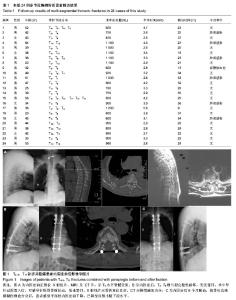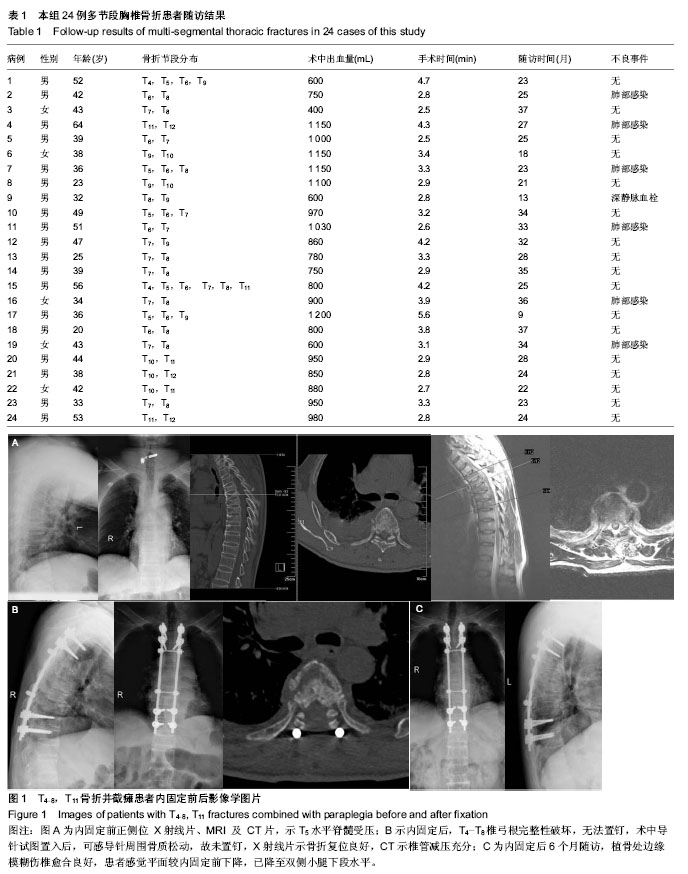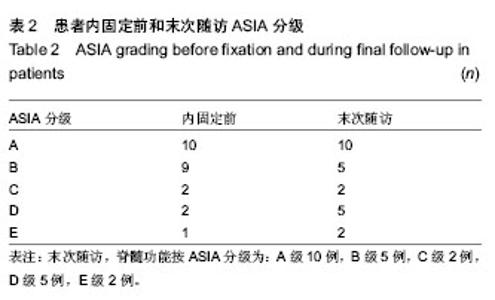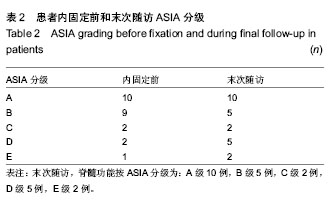| [1] Leucht P,Fischer K,Muhr G, et al.Epidemiology of traumatic spine fractures. Injury. 2009;4:166-172.
[2] Wang H, Zhang Y, Xiang Q, et al. Epidemiology of traumatic spinal fractures: experience from medical university-affiliated hospitals in Chongqing, China, 2001-2010.J Neurosurg Spine. 2012;17(5):459-468.
[3] Jiang B, Zhu R, Cao Q, et al. Severe thoracic spinal fracture-dislocation without neurological symptoms and costal fractures: a case report and review of the literature. J Med Case Rep. 2014;8:343.
[4] Müller CW, Otte D, Decker S, et al. Vertebral fractures in motor vehicle accidents - a medical and technical analysis of 33,015 injured front-seat occupants. Accid Anal Prev. 2014; 66:15-19.
[5] Parenteau CS, Viano DC.Spinal fracture-dislocations and spinal cord injuries in motor vehicle crashes.Traffic Inj Prev. 2014;15(7): 694-700.
[6] Magerl F, Aebi M, Gertzbein SD, et al. A comprehensive classification of thoracic and lumbar injuries. Eur Spine J. 1994; 3:184-201.
[7] Malberg MI.A new system of classification for spinal injuries. Spine J. 2001;1(1):18-25.
[8] Morita D, Yukawa Y, Nakashima H, et al. Range of motion of thoracic spine in sagittal plane. Eur Spine J. 2014;23(3): 673-678.
[9] Padulo J, Ardigò LP. Letter to the editor concerning "range of motion of thoracic spine in sagittal plane". Eur Spine J. 2014; 23(7):1576-1577.
[10] Lee DH, Kim NH, Hwang CJ, et al. Neglected esophageal perforation after upper thoracic vertebral fracture. Spine J. 2011;11(12):1146-1151.
[11] Cawthon PM, Blackwell TL, Marshall LM, et al. Physical performance and radiographic and clinical vertebral fractures in older men. J Bone Miner Res. 2014;29(9):2101-2108.
[12] Soultanis KC, Mavrogenis AF, Starantzis KA, et al. When and how to operate on thoracic and lumbar spine fractures? Eur J Orthop Surg Traumatol. 2014;24(4):443-451.
[13] Plog BA, Pierre CA, Srinivasan V. Neurologic injury in snowmobiling. Surg Neurol Int. 2014;5:87.
[14] Schouten R,Keynan O,Lee RS,et al. Health-related quality-of-life outcomes after thoracic (T1-T10) fractures. Spine J. 2014;14(8):1635-1642.
[15] Li C, Zhou Y, Wang H, et al. Treatment of unstable thoracolumbar fractures through short segment pedicle screw fixation techniques using pedicle fixation at the level of the fracture: a finite element analysis. PLoS One. 2014;9(6): 99156.
[16] 周方,陈仲强,刘忠军,等.中上胸椎骨折脱位的临床特点及手术治疗[J].中华创伤骨科杂志,2004, 6(11):1226-1228.
[17] Cheng LM, Wang JJ. Pedicle screw fixation for traumatic fractures of the thoracic and lumbar spine. Cochrane Database Syst Rev. 2013;5:CD009073.
[18] 唐三元,徐永年,陈庄洪.多节段脊柱骨折的分类及相关问题研究[J]. 中国矫形外科杂志,1995, 3(2):238-240.
[19] 李利,史亚民,侯树勋,等.多节段脊柱骨折的诊断表述与手术治疗[J].脊柱外科杂志, 2004, 2(1):7-10.
[20] 季承,杨惠林.多节段非相邻型脊柱骨折的诊断与治疗[J].中国脊柱脊髓杂志,2011,21(11):895-899.
[21] 王洪伟,王许可,李长青,等.多节段非相邻型脊柱骨折的致伤机制及伤情特点[J].中国矫形外科杂志, 2013, 21(2):132-135.
[22] 刘志勇,陈磊,费志强,等.椎弓根螺钉固定治疗中上胸椎骨折的临床疗效观察[J]. 中国现代手术学杂志,2013, 17(2): 123-126.
[23] Boerger TO,Limb D,Dickson RA.Doses canal clearance affect neurological outcome after thoracolumbar burst fractures? J Bone Joint Surg(Br). 2000; 82:629-635.
[24] 杨海林,李宽新,董金波.内固定治疗胸椎骨折脱位伴脊髓损伤[J]. 实用骨科杂志, 2012, 18(7): 626-628.
[25] 戴胡明,方诗元,夏睿,等.传统入路与椎旁肌间隙入路置入椎弓根螺钉治疗胸腰段骨折[J]. 中国组织工程研究, 2013,17(13): 2339-2345.
[26] 明江华,郑慧锋,赵奇,等. Sextant经皮椎弓根钉棒微创系统治疗胸腰椎骨折:随访评价[J].中国组织工程研究, 2013,17(18): 8343-8348.
[27] Allain J.Anterior spine surgery in recent thoracolumbar fractures: An update. Orthop Traumatol Surg Res. 2011;97(5): 541-554.
[28] Wu H,Fu C,Yu W,et al.The options of the three different surgical approaches for the treatment of Denis type A and B thoracolumbar burst fracture. Eur J Orthop Surg Traumatol. 2014;24(1):29-35.
[29] Bazzocchi A, Fuzzi F, Garzillo G, et al. Reliability and accuracy of scout CT in the detection of vertebral fractures. Br J Radiol.2013;86(1032):20130373.
[30] 崔新刚,张佐伦,丁自海,等.胸椎上关节突基底外1/3点为椎弓根进针点的应用解剖[J].中国临床解剖学杂志,2006,24(1):32-35.
[31] Yang M, Wang XB, Li J, et al. Implanting pedicle screw in fractured vertebra results in no adverse effect on bone healing in thoracic or lumbar burst fracture.Turk Neurosurg. 2013;23(6):778-782.
[32] Zhang QS, Lu GH, Wang XB, et al. The significance of removing ruptured intervertebral discs for interbody fusion in treating thoracic or lumbar type B and C spinal injuries through a one-stage posterior approach. PLoS One. 2014; 9(5): e97275.
[33] 韦寿繁.上胸椎骨折脱位的手术治疗进展[J].医学综述,2013, 19(24):4487-4490.
[34] Tamburrelli FC, Scaramuzzo L, Genitiempo M. Minimally invasive treatment of the thoracic spine disease: completely percutaneous and hybrid approaches. Minim Invasive Surg. 2013;2013:508920. |



